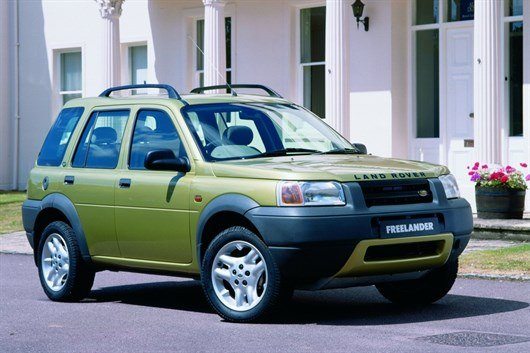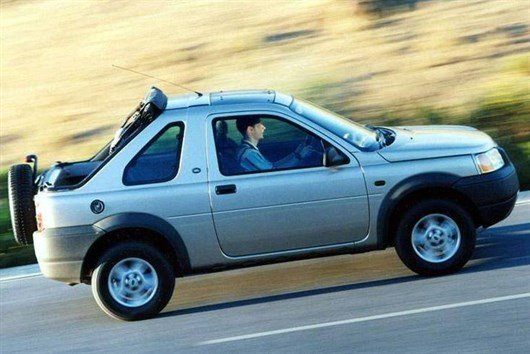Future Classic Friday: Land Rover Freelander

Nicknamed 'the hippo' in Land Rover circles, partly for its penchant for wallowing in mud, but more for its furrowed looks, the original Freelander is about to celebrate its 20th birthday.
It's astonishing to think, looking at where the Land Rover brand sits today, that the addition of a compact SUV to the company's line up took so long to materialise (or indeed, that it increased the model range from three to just four when it made its debut). The others being the Discovery, Defender and Range Rover P38, which at the time was the standalone bearer of the Range Rover name.
It was a long time in gestation, too. Land Rover had been planning a smaller model than the Discovery since the late Eighties. Indeed, many of the Freelander prototypes were disguised in Metro and Maestro bodyshells, or towards the end of development the body of the Maestro van, which was about the same length.

It was when BMW took over Rover Group in 1994 that the funds were available to finally press ahead with the CB40 project, as it was known internally.
The engineering team were given just three years to bring it to fruition and, as the car included a number of firsts, there was also a need to cut budget in places. As a result, the final car, launched in 1997, had some recognisable Rover Group 'parts bin' bits, including the air vents from the Rover Metro (albeit dyed green), Rover 800 headlight, wiper and indicator controls, the 800 radio head unit (again jauntily coloured) and electric window switches that could trace their heritage back as far as the Austin Montego...
But on the advanced side, it was Land Rover's first ever vehicle to be of monocoque unitary construction, rather than on a separate chassis. It was also the first ever SUV to feature Hill Descent Control, along with a viscous coupling, off-road specific traction control and the IRD (or Intermediate Reduction Drive), which acted as both transfer box and front propshaft, ensuring the impeccable off-road performance that Land Rover was so keen to retain. The IRD, though, would later prove itself to be one of the model's most common failure points, alongside K-series petrol-engined models' head gaskets.

The first Freelander to appear was the three-door, which came with a removable rear hardtop to give semi-open top motoring, with the rear window glass being fully retractable using a console-mounted switch for the full open-top experience. A softback option was also available.
Later on that year, Land Rover revealed a more family-friendly Freelander, this time with five doors, though it retained the drop-down rear window and stalk-mounted brake light of the three-door, both of which were hallmarks of the model.
Two powerplants were on offer at launch - the 1.8 K-series, which was lifted from the MGF, and the 2.0-litre L-series turbodiesel, a Rover Group stalwart that was lively and reliable, but came with a deafening price. In 2001, a V6 model appeared using the troublesome combination of Rover's KV6 engine and a Jatco automatic gearbox, which gave the model a foothold in the USA, along with new Td4 models that used the 2.0-litre diesel engine from BMW's 3- and 5-series, which Rover had recently introduced into the 75 saloon. These were far more refined than the L-series, though the older unit is practically indestructible so shouldn't be discounted.

Although the final execution wasn't as exemplary as it could have been, the Freelander was an instant hit, and sailed immeidately to the top of the UK's SUV sales charts, where it remained until it was replaced by the Freelander2 in 2006.
The new car was visually relatable to the earlier one, but the slow-selling three-door models were dropped, while it was also significantly more mature and further developed, using many of the features seen on the Discovery3 of two years previous. Land Rover was now under Ford ownership, and its growth to become the multi-model brand it is now was already well underway.
But without the original Freelander firing the imagination of the company's engineers and designers, as well as introducing a whole new generation of buyers to the Land Rover brand, the company may not have achieved the success it enjoys today. The Freelander may have been a long time coming, but it was the right car at exactly the right time - and if those are the ingredients for a proper classic, then it won't be long before the earliest examples are in high demand...
Comments
Compare classic car insurance quotes and buy online. A friendly service offering access to a range of policies and benefits.


 Craig Cheetham
Craig Cheetham
 NEC classic motor show 2020 postponed due to Covid 19 concerns
NEC classic motor show 2020 postponed due to Covid 19 concerns
 Classic car auction house Coys goes into administration
Classic car auction house Coys goes into administration
 Motor racing great Sir Stirling Moss dies aged 90
Motor racing great Sir Stirling Moss dies aged 90
 Alfa Romeo anniversary races set for Silverstone
Alfa Romeo anniversary races set for Silverstone
 Government to make E5 fuel available for classic owners
Government to make E5 fuel available for classic owners
 Plans to introduce cleaner fuel could damage more than a million classic cars
Plans to introduce cleaner fuel could damage more than a million classic cars
 Top 10: Classic cars from the Gulf motor racing heritage collection
Top 10: Classic cars from the Gulf motor racing heritage collection











Add a comment